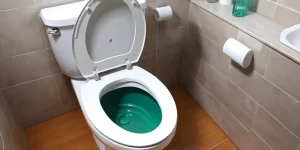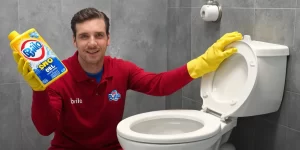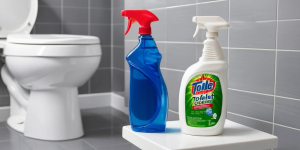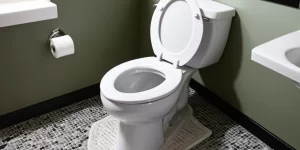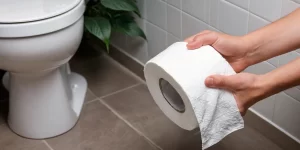When it comes to maintaining a clean and sanitary bathroom, understanding the right products to use can make all the difference. One of the most effective and popular choices in toilet cleaning is Phosphoric Acid Toilet Cleaner. This powerful compound not only helps tackle tough stains and mineral buildup but also has a variety of applications beyond household cleaning. In this guide, we will explore how phosphoric acid works to effectively cleanse your toilet, along with step-by-step instructions for safe usage. Additionally, we will discuss important safety tips, ventilation needs, and common mistakes to avoid, ensuring you have all the information necessary for a thorough and safe cleaning routine. Moreover, we will touch on alternative cleaning methods and environmental considerations, enabling you to make informed choices for both your home and the planet. Let’s dive in and uncover the secrets behind this potent cleaning agent!
What is Phosphoric Acid and Its Uses?
Phosphoric acid, a colorless, odorless liquid, is a versatile inorganic acid with various applications in household and industrial settings. Chemically known as H₃PO₄, it is commonly found in fertilizers, food products, and cleaning agents, making it a staple in many industries.
Key Uses of Phosphoric Acid
| Application | Description |
|---|---|
| Food Additive | It acts as an acidity regulator and is often used in soft drinks and processed foods to enhance flavor. |
| Fertilizers | Phosphoric acid is a primary component in phosphate fertilizers, essential for plant growth and crop yield. |
| Rust Removal | Used in rust converters and metal treatment, it effectively removes corrosion and prepares surfaces for painting. |
| Toilet Cleaners | As a cleaning agent, phosphoric acid dissolves mineral deposits, stains, and hard water build-up, contributing to a cleaner toilet bowl. |
| Dental Preparations | In dentistry, it is used to etch tooth enamel before applying certain treatments, ensuring a strong bond. |
Overall, phosphoric acid serves a multitude of purposes, but its potency as a Phosphoric Acid Toilet Cleaner makes it particularly noteworthy. Its effectiveness in cleaning is attributed to its ability to break down tough stains and deposits that standard cleaners may struggle to remove. This versatility, combined with its widespread availability, solidifies phosphoric acid’s place as a crucial compound in both daily cleaning routines and industrial processes.
How Phosphoric Acid Works as a Toilet Cleaner
Phosphoric Acid Toilet Cleaner is a powerful solution that breaks down tough stains and deposits, making it highly effective for maintaining a clean toilet bowl. Understanding how it works can help you use it more effectively and safely. Here’s a closer look:
Mechanism of Action
| Component | Function |
|---|---|
| Acidic Properties | Phosphoric acid has strong acidic properties that help dissolve mineral deposits, such as limescale and rust. These deposits commonly occur in toilets due to hard water. |
| pH Level | The low pH level makes it effective in breaking down organic materials and disinfecting surfaces, ensuring a thorough clean. |
| Surface Interaction | When applied to the toilet bowl, phosphoric acid interacts chemically with stains, loosening them from the ceramic surface, which allows for easier scrubbing and removal. |
Application Process
- Targeted Cleaning: Pour the Phosphoric Acid Toilet Cleaner around the rim of the toilet bowl, ensuring even coverage. This targeted application helps maximize effectiveness.
- Wait: Allow the cleaner to sit for about 15-20 minutes. This waiting period enables the acid to break down the stains effectively.
- Scrubbing: Use a toilet brush to scrub the bowl. The staining materials should release easily, offering a cleaner, brighter finish.
Using Phosphoric Acid in your toilet cleaning regimen not only addresses existing stains but also helps prevent future buildup. Always remember to follow safety precautions when applying the cleaner and to maintain proper ventilation in the area.
Benefits of Using Phosphoric Acid for Toilet Cleaning
Toilet cleaning can often feel like a daunting task, but utilizing Phosphoric Acid Toilet Cleaner can transform your experience into a more efficient and effective process. Here are some key benefits that make it a preferred choice:
| Benefit | Description |
|---|---|
| Powerful Stain Removal | Phosphoric acid effectively breaks down tough mineral deposits, rust stains, and limescale that accumulate in toilets over time. |
| Fast-acting Formula | It works quickly, allowing you to see results with minimal waiting time, typically cleaning your toilet within a few short minutes. |
| Corrosion Control | Unlike other harsh chemicals, phosphoric acid can dissolve corrosion while protecting your toilet’s porcelain finish from further damage. |
| pH Balancing | It helps in maintaining a balanced pH in your toilet’s plumbing system, promoting longevity and cleanliness. |
| Cost-Effective | Available in various formulations, Phosphoric Acid Toilet Cleaner is often more affordable than other specialized cleaners on the market. |
Improved Hygiene
Using phosphoric acid not only cleans the toilet but also helps eliminate bacteria and germs typically found in these spaces. By regularly maintaining cleanliness with this product, you enhance the hygiene of your bathroom.
Environmentally Friendly Options
Many formulations of phosphoric acid are designed to be eco-friendly. Choosing a variation that meets environmental standards allows you to clean effectively while being mindful of the impact on your surroundings.
In summary, the benefits of using Phosphoric Acid Toilet Cleaner extend far beyond simple aesthetics, making it an admirable choice for your cleaning routine.
Step-by-Step Guide to Cleaning Your Toilet with Phosphoric Acid
Using Phosphoric Acid Toilet Cleaner can effectively tackle tough stains and mineral deposits in your toilet. However, it’s essential to follow specific steps to ensure that the process is efficient and safe. Here’s a step-by-step guide to help you clean your toilet properly:
| Step | Action | Details |
|---|---|---|
| 1 | Gather Supplies | You’ll need rubber gloves, a toilet brush, safety goggles, and the Phosphoric Acid Toilet Cleaner. Ensure all items are within reach. |
| 2 | Prepare the Area | Clear the floor around the toilet to prevent slips and remove any items from the toilet tank for a thorough cleaning. |
| 3 | Apply Cleanser | Pour an adequate amount of the Phosphoric Acid Toilet Cleaner around the toilet bowl, focusing on stains and buildup. Allow it to sit for about 5-10 minutes for maximum effectiveness. |
| 4 | Scrub the Toilet | Using a toilet brush, scrub thoroughly under the rim and around the bowl. The acid will help break down tough stains. |
| 5 | Flush the Toilet | After scrubbing, flush the toilet to rinse away the cleaner and any loosened debris. |
| 6 | Inspect and Repeat if Necessary | Check for any remaining stains or buildup. If needed, repeat the application and scrubbing process until the toilet is spotless. |
| 7 | Clean Up | Safely dispose of any cleaning materials and wash your gloves. Make sure to clean up any splashes quickly to avoid damage or slips. |
By following this structured approach, you can effectively clean your toilet using Phosphoric Acid Toilet Cleaner while minimizing risks and maximizing results.
Safety Precautions When Using Phosphoric Acid
When using Phosphoric Acid Toilet Cleaner, it’s essential to prioritize safety to avoid accidents and harmful exposure. Here are some critical safety precautions to consider:
| Precaution | Description |
|---|---|
| Wear Protective Gear | Always wear gloves, goggles, and a mask. This will protect your skin, eyes, and respiratory system from irritation. |
| Check for Surface Compatibility | Ensure that the cleaner is safe for your toilet material. Some surfaces may react negatively to phosphoric acid. |
| Avoid Mixing Chemicals | Do not mix Phosphoric Acid Toilet Cleaner with other cleaners, especially those containing bleach, as it can produce toxic fumes. |
| Keep Away from Children and Pets | Store the cleaner out of reach to prevent accidental ingestion or contact. |
| Use in Small Quantities | Apply only the amount you need. Overuse can lead to damage to the toilet and increase the risk of spills. |
| Read Labels Carefully | Always read the manufacture instruction and safety data sheets for detailed information on handling and emergency measures. |
| Have Water Ready | Keep a bucket of water nearby to dilute any spills immediately. This can help minimize damage and prevent injury. |
By adhering to these safety measures, you can effectively use Phosphoric Acid Toilet Cleaner while ensuring a safe environment for yourself and others. Remember, safety is paramount to effective cleaning.
Proper Ventilation When Cleaning with Phosphoric Acid
When cleaning your toilet with Phosphoric Acid Toilet Cleaner, ensuring proper ventilation is crucial for safety. This acid, while effectively breaking down tough stains and mineral deposits, emits fumes that can be harmful if inhaled. Here are important considerations to ensure a safe cleaning environment:
Why Ventilation Matters
Ventilation helps to dilute and disperse potentially harmful fumes in the air. According to the Environmental Protection Agency (EPA), inadequate ventilation can lead to respiratory issues, headaches, and other health problems.
Tips for Ensuring Proper Ventilation:
| Method | Description |
|---|---|
| Open Windows | Ensure at least one window is fully open to create cross-ventilation. This allows fresh air to circulate throughout the space. |
| Use Exhaust Fans | Turn on exhaust fans, if available, to actively pull stale air out of the bathroom. This is especially helpful if windows cannot be opened fully. |
| Limit Time Indoors | Try to minimize the time spent in the bathroom while cleaning. Step out frequently to breathe fresh air. |
| Personal Protective Equipment | Consider wearing a mask or face shield to further protect yourself from inhaling fumes. |
Additional Suggestions
- Plan Your Cleaning Time: Choose a time when no one else will be using the restroom. This minimizes the exposure of others to harmful fumes.
- Read Labels: Always check product instructions or safety data sheets for any recommendations regarding ventilation.
By following these ventilation tips, you can effectively clean your toilet with Phosphoric Acid Toilet Cleaner while safeguarding your health. Prioritizing proper airflow will make your cleaning endeavors not only effective but also safe.
Common Mistakes to Avoid with Phosphoric Acid
When using Phosphoric Acid Toilet Cleaner, it’s crucial to be aware of potential pitfalls to ensure effective cleaning and safety. Avoiding these common mistakes will help you achieve the best results while maintaining a safe environment.
| Mistake | Description |
|---|---|
| Not Diluting Properly | Users often apply Phosphoric Acid without dilution, which may lead to surface damage in the toilet or permanent stains. Always follow manufacturer instructions for dilution rates. |
| Ignoring Safety Gear | Skipping gloves and goggles is a frequent oversight. This acid can cause skin irritation and eye damage; hence, protective gear is essential. |
| Using on Damaged Surfaces | Applying Phosphoric Acid on already damaged or porous surfaces can exacerbate damage. Conduct a quick inspection before usage. |
| Mixing with Other Cleaners | Combining different chemicals can result in toxic reactions. Stick to using Phosphoric Acid as a standalone cleaner. |
| Neglecting Contact Time | Rushing the cleaning process and not allowing the acid to sit for the recommended time can lessen the cleaning effectiveness. Always let it rest as directed. |
| Ignoring Ventilation | Failing to ensure proper ventilation can lead to inhalation of harmful fumes. Always open windows and use fans to circulate air during and after cleaning. |
By staying mindful of these common pitfalls, you can maximize the effectiveness of your Phosphoric Acid Toilet Cleaner while ensuring a safer cleaning experience. Remember to follow all instructions carefully, and you’ll enjoy a cleaner and fresher toilet without the unwanted consequences.
Storing Phosphoric Acid Safely
When it comes to handling Phosphoric Acid Toilet Cleaner, proper storage is crucial to ensure safety and maintain its effectiveness. Here are some essential tips to help you store phosphoric acid safely:
| Storage Tip | Details |
|---|---|
| Cool, Dry Place | Always store phosphoric acid in a cool and dry area to prevent degradation. Avoid places that are exposed to direct sunlight or high temperatures. |
| Use Appropriate Containers | Keep phosphoric acid in containers specifically designed for acidic substances. Glass or certain types of plastic will work well, but avoid metal containers that can corrode. |
| Label Clearly | To prevent accidental misuse, ensure that containers are clearly labeled with the contents and safety information. Use appropriate hazard symbols if necessary. |
| Secure Storage | Store the acid in a locked cabinet or shelf out of reach of children and pets. This prevents any accidental exposure and keeps it away from unauthorized users. |
| Avoid Mixing | Never store phosphoric acid with other chemicals, especially bases or reactive substances. Mixing can lead to hazardous reactions. |
By following these guidelines, you can minimize the risks associated with storing Phosphoric Acid Toilet Cleaner. Regularly check the storage conditions and the integrity of the containers to ensure that everything remains safe and effective for your cleaning tasks.
Alternatives to Phosphoric Acid in Toilet Cleaning
While Phosphoric Acid Toilet Cleaner is a popular choice for tackling stubborn stains and limescale, there are several effective alternatives that can provide excellent cleaning results without the potential hazards associated with acids. Here are some noteworthy options:
| Cleaning Agent | Effectiveness | Safety Level | Environmental Impact |
|---|---|---|---|
| Baking Soda | Moderate (scours and neutralizes odors) | Very Safe | Low |
| Vinegar | High (dissolves mineral buildup) | Very Safe | Low |
| Hydrogen Peroxide | High (disinfects and removes stains) | Safe (in diluted form) | Low |
| Borax | Moderate (prevents mold and stains) | Generally Safe | Low |
| Citric Acid | High (dissolves limescale) | Safe | Low |
Baking Soda
A household staple, baking soda is a natural cleaner that helps neutralize odors while providing gentle scrubbing action. Combine it with vinegar for enhanced cleaning.
Vinegar
Vinegar is a powerful natural solution that effectively breaks down mineral deposits, such as limescale, and can also eliminate odors. Its acidic nature allows it to work similarly to phosphoric acid but with less risk.
Hydrogen Peroxide
This versatile disinfectant can be used to clean toilets that need a more robust approach for bacteria and stains. Use it in a diluted form for safety.
Borax
Ideal for long-term maintenance, borax not only prevents staining but also helps to kill mold and bacteria.
Citric Acid
Citric acid is a popular environmentally-friendly option that is particularly effective against hard water stains, enhancing the cleaning power of your toilet routine.
Choosing the right alternative can maintain your toilet’s cleanliness while ensuring a safer cleaning experience.
Environmental Considerations of Using Phosphoric Acid
When utilizing Phosphoric Acid Toilet Cleaner, it’s essential to consider the environmental impact of this solution. Phosphoric acid is effective at breaking down mineral deposits and stains, but its use requires careful thought regarding both disposal and potential runoff. The following points outline key environmental considerations:
| Consideration | Details |
|---|---|
| Water Pollution Risk | Phosphates can contribute to the eutrophication of water bodies, leading to algal blooms that deplete oxygen. Ensure runoff is prevented during cleaning. |
| Soil Contamination | If spilled or improperly disposed of, phosphoric acid can affect soil health. Follow proper disposal guidelines to minimize risks. |
| Biodegradability | Phosphoric acid is not biodegradable, thus potential harm to ecosystems can linger long after application. Utilize sparingly and follow instructions. |
| Impact on Wildlife | Ingesting contaminated water can be harmful to wildlife. Ensure areas treated are not within reach of local fauna. |
Using Phosphoric Acid Toilet Cleaner requires an awareness of both its cleaning power and its environmental consequences. To minimize risks, always opt for environmentally friendly alternatives when possible, and maintain vigilant disposal practices. Regularly monitoring cleaning routines and considering less harmful cleaning agents can lead to a more sustainable cleaning approach while still effectively maintaining bathroom hygiene.
Frequently Asked Questions
What is phosphoric acid and how is it used in toilet cleaners?
Phosphoric acid is a colorless, odorless liquid that is commonly used in cleaning products, including toilet cleaners, due to its effectiveness in dissolving mineral deposits and stains. It works by reacting with the calcium and magnesium found in hard water stains, breaking them down and easing their removal. This property makes it especially useful for cleaning toilet bowls, where hard water deposits often accumulate, providing a cleaner and healthier restroom environment.
Are there any safety precautions to consider when using phosphoric acid toilet cleaners?
Yes, there are important safety precautions to take when using phosphoric acid toilet cleaners. Always wear protective gloves and, ideally, goggles to prevent chemical splashes from coming in contact with your skin or eyes. Ensure that the area is well-ventilated, as the fumes can be harmful if inhaled. Additionally, avoid mixing phosphoric acid cleaners with other cleaning products, particularly those containing bleach, as this can produce harmful gases. Always read the label for specific warnings and instructions.
Can phosphoric acid damage toilet fixtures or plumbing?
When used as directed, phosphoric acid toilet cleaners should not damage standard toilet fixtures or plumbing. However, prolonged exposure or using the product in excessively high concentrations can lead to corrosion over time. It’s important to follow the manufacturer’s guidelines for use and maintenance. If you have older fixtures or plumbing made from materials like brass or certain metals, it’s wise to check compatibility before use.
How often should I use phosphoric acid toilet cleaners?
The frequency of using phosphoric acid toilet cleaners may vary depending on water hardness and toilet usage. For most households, cleaning once every one to two weeks is sufficient to avoid significant buildup of stains and mineral deposits. However, in areas with extremely hard water or for toilets that receive heavy use, more frequent cleaning may be necessary to maintain cleanliness and hygiene.
What are the environmental impacts of phosphoric acid toilet cleaners?
Phosphoric acid, while effective in cleaning, can have environmental impacts if not disposed of properly. When phosphoric acid enters waterways, it can contribute to nutrient pollution, potentially leading to harmful algal blooms that affect aquatic ecosystems. Therefore, it is crucial to follow local disposal regulations and avoid pouring large quantities down the drain. Opting for eco-friendly cleaning products and methodologies can help minimize any negative environmental effects.
